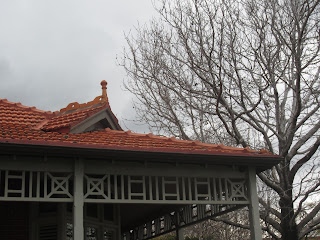I went along the seashore to begin with:
but then I turned inland:
I passed a building that Hercule Poirot might be happy to call home:
and then walked through street upon street of Edwardian fantasy:
As usual, I was hoping to see faces looking down from the walls around me. To my surprise, there were none. It seems that the architects of Middle Park and Albert Park preferred patterns to people when it came to external decoration:
They also preferred a lot to a little, piling on detail after detail with an admirable lack of restraint. Windows were leadlighted, rooftops were edged with terracotta trim and verandahs with carved wooden braiding:
Although it wasn't possible to capture with my camera, even the slate in the rooves was often laid in herringbone or zigzag patterns.
I admired the confidence displayed by some long-gone small business owner. He clearly believed his enterprise would last as long as his building:
I wondered what significance the names that some of the older buildings bore had once had and whether anyone still understood them:
Most of all, I felt sad that none of the streetscapes built in my lifetime will offer anywhere near the visual pleasure of suburbs created when the urban world was still largely handmade.











































































…. especially woodwork. A man with average carpentry skills but a little imagination could create something of beauty, a feeling of winter warmth or coolness in summer. Wives and kids could paint and together they could adorn their homes after their own style. That's why these were homes, on a quarter acre block a lot of the time, with pets and trees and gardens.
ReplyDeleteSome of that survived, along with the mastercraftmanship, and its value was recognised and retained by people who understood the virtues of life spanning the decades of the mid-twentieth century. And you were walking through its legacy.
I heard Clive James on Radio 3's Arts and Ideas the other day. He said something to the effect that it took him far too long to realise that real happiness comes from taking a lot of trouble to make something to the best of your ability. More and more we are robbed of opportunities to do that.
ReplyDeleteWonderful.
ReplyDeletePleased to meet you and to discover your blog.
Delete